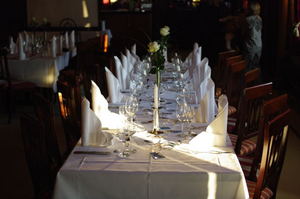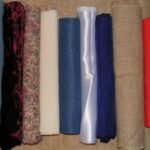When hosting a dinner party, holiday get-together, or other occasion, adding pretty folded napkins on the table is a nice touch. Folded napkins can be set on the table as an accent on plate settings, inside wine or water glasses, or even garnished with a bow or floral sprig. In this article, we’ll discuss some easy napkin folding techniques that you can use at your next special dinner occasion. To begin with, these easy napkin folding techniques will work best with cloth napkins. To save money, you can buy fabric at your local craft or sewing supply store, and create dinner or cocktail napkins on your own. To make your own napkins, cut the fabric into the size you desire and then pull the loose threads away. Hem the edges and sew closed.
Once you’ve selected a nice cloth napkin fabric, you’re ready to begin folding the napkins. Here are some easy napkin folding techniques.
Butterfly Fold
The Butterfly fold is one of the easiest napkin folding techniques there is. Sometimes referred to as the Fan Fold, it takes very little time to assemble, but looks nice on the table.
– With the napkin facing up, pleat it accordion style from corner to corner.
– Fold the napkin in half, and insert a napkin ring, allowing the sides of the napkin to flair out.
– Add a decorative ribbon that matches the theme of your party. For example, red and gold for Christmas, patriotic stars for the 4th of July, or solid colored ribbon can be used if you have selected a printed napkin pattern.
Napkin Pocket
The Napkin Pocket is aptly named because when it is complete, silverware can be placed inside the folded napkin and displayed nicely. When assembled, the Napkin Pocket will slightly resemble the front pocket on a dress shirt.
– Pick up the napkin using two hands, holding the corners.
– Fold down the napkin in three folds at the middle of the napkin, so that they measure about 1″ each. (You’ll have excess fabric above and under the napkin folds)
– Carefully flip the napkin over.
– Bring the right side of the napkin into the center, and repeat with the left side. Be sure both sides meet in the middle.
– Fold the napkin in half where the edges meet. (This should form a rectangle with a pocket on each side)
– Now you can place your silverware into the pocket, and it can be put on a plate setting.
Bishop’s Hat
This napkin folding technique is typically seen in formal restaurants. It is called the Bishop’s Hat because when it is complete, it will resemble a hat similar to that worn by a Bishop.
– Fold napkin in half diagonally.
– With fold at the bottom, bring the bottom point up so they meet the top points.
– Fold lower points to 1″ below the top point.
– Fold lower points back to meet bottom fold and curve sides to back and tuck one in. (This will form a base which will allow the napkin to stand upright)
– Fold down the two front points to finish the Bishop’s Hat.
Napkin Roses
Add a delicate touch to the dinner table with beautiful Napkin Roses. Obviously, using a pink or red fabric works best for this type of napkin.
– Fold napkin in half diagonally. The fold should be at the bottom.
– Turn lower right corner up at a 1″ angle and fold.
– Pint the angle to hold tight, and scrunch the remaining fabric and roll from right to left.
– The napkin should now resemble a rose, and it can be tied securely with a ribbon or held in place with a napkin ring.
Triangle Fold
If any of these napkin folding techniques seem a bit confusing, you’ll find the Triangle Fold a relief. There is really nothing to this, and anyone (that includes you!) can do this easy napkin folding technique.
– Spread your napkin out on the table.
– Fold the left bottom corner to the top right corner.
– You will have made a triangle shape with the napkin.
– Now take the bottom right corner and bring it up to the top left corner.
– You’ll have made a smaller triangle.
– Carefully gather the napkin, and push a napkin ring over top of the material sticking up.
** To read more from this author, CLICK HERE.
SOURCE:
Personal knowledge & experience




